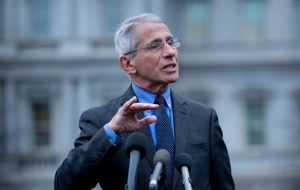MercoPress. South Atlantic News Agency
On Easter Sunday, US death toll surpasses 22.000; May first, tentative date for relaxing stay at home restrictions
 The United States has recorded more fatalities from the COVID-19 disease caused by the coronavirus than any other country in the world
The United States has recorded more fatalities from the COVID-19 disease caused by the coronavirus than any other country in the world  Dr. Anthony Fauci and other public health experts say widespread testing will be key to efforts to reopen the economy, including antibody tests
Dr. Anthony Fauci and other public health experts say widespread testing will be key to efforts to reopen the economy, including antibody tests Americans spent Sunday on lockdown as the US toll from the COVID-19 pandemic surpassed 20,000 deaths and more than half a million confirmed cases. With almost all the country under stay-at-home orders to curb the spread of the disease, many turned to online church services to mark the holiest day in the Christian calendar.
“Future generations will look back on this as the long Lent of 2020, a time when disease and death suddenly darkened the whole earth,” Archbishop Jose Gomez of Los Angeles wrote to priests and parishioners nationwide, urging them to hold steadfast.
“Our churches may be closed but Christ is not quarantined and his Gospel is not in chains.”
The United States has recorded more fatalities from the COVID-19 disease caused by the coronavirus than any other country in the world. About 2,000 deaths a day were reported for the last four days in a row – the largest number in and around New York City.
Even that is viewed as understated, as New York is still figuring out how best to include a surge in deaths at home in its official statistics. As of Sunday, the US had 22,020 deaths and 555,313 infections, according to a tally by Johns Hopkins University.
As the death toll has mounted, President Donald Trump mulled over when the country might begin to see a return to normality.
The sweeping restrictions on non-essential movement that were imposed in recent weeks across 42 states have taken a huge toll on commerce and raised questions over how long business closures and travel curbs can be sustained.
The number of Americans seeking unemployment benefits in the last three weeks surpassed 16 million.
The Trump administration sees May 1 as a target date for relaxing the stay-at-home restrictions, the commissioner of the Food and Drug Administration, Stephen Hahn, said on Sunday. But he cautioned that it was still too early to say whether that goal would be met.
“We see light at the end of the tunnel,” Hahn told ABC's “This Week,” adding, “Public safety and the welfare of the American people has to come first. That has to ultimately drive these decisions”
Dr Anthony Fauci, the country's top US infectious disease expert, said he was cautiously optimistic and pointed to the New York metropolitan area, which had its highest daily death toll last week but also saw a decrease in hospitalizations, intensive care admissions and the need to intubate critically ill patients.
“Once you turn that corner, hopefully you'll see a very sharp decline and then you can start thinking about how we can keep it that way,” Fauci said on CNN's State of the Union.
“If all of a sudden we decide 'OK, it's May whatever,' and we just turn the switch on, that could be a real problem.”
Fauci and other public health experts say widespread testing will be key to efforts to reopen the economy, including antibody tests to find out who has already had the disease and could be safe to return to work.
Hahn said he was concerned that some antibody tests on the market that had not gone through the FDA scientific review process “may not be as accurate as we'd like them to be.”
“I can assure the American people that what we're doing is using data and science to look at those tests to make sure that they're valid, they're accurate and they're reproducible,” he said.
New government data shows a summer surge in infections if stay-at-home orders are lifted after only 30 days, according to projections first reported by the New York Times and confirmed by a Department of Homeland Security official.




Top Comments
Disclaimer & comment rulesCommenting for this story is now closed.
If you have a Facebook account, become a fan and comment on our Facebook Page!